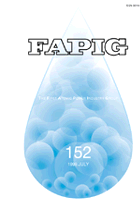

FAPIG
THE FlRST ATOMlC POWER INDUSTRY GROUP
FAPIG誌 最新号目次
1999-7/平成11年度 第1号
(No.152)

|
■ 報 告 FBR実証炉 燃料取扱・貯蔵設備の合理化研究(3) 植田正弘 / 尾崎 博 / 古賀和浩 / 堀 徹 ■ 紹 介 核融合炉用超電導機器の開発 (11) 上出俊夫 / 今野雅行 / 樋上久彰 使用済燃料横型サイロ貯蔵施設について (17) 南 了悟 / 中田哲夫 ■ 解 説 高レベル放射性廃棄物処分の動向 (27) 能見光彦 ■ グループ情報 渋沢倉庫 神戸港PC16/17コンテナターミナルにおけるブースレス・ゲートシステム (34) 井島 孝 FAPIGの機構 (40) 表紙デザイン:中村加奈女 CONTENTS ■ Report Demonstration Fast Breeder Reactor Plant Rationalization Study of Fuel Handling and Storage System (3) M. Ueta / H. Ozaki / K. Koga / T. Hori ■ Introduction Development of Superconducting Apparatus for Fusion Reactor (11) T. Uede / M. Konno / H. Hiue Horizontal Modular Storage System for Spent Nuclear Fuel (17) R. Minami / T. Nakata ■ Commentary The Trend of the High Radioactive Waste Disposal (27) M. Nohmi ■ FAPIG Activities Boothless Gate System in PC16/17 Container Terminal in Kobe Port (34) T. Ijima Cover Design:Kaname Nakamura SYNOPSES Toshio Uede, Masayuki Konno, Hisaaki Hiue Development of Superconducting Apparatus for Fusion Reactor FAPIG No. 152 pp. 11〜16 (1999) Fuji Electric Co., Ltd. has developed current leads, superconducting feeder system and superconducting coils as superconducting apparatus for fusion reactor. We made 60kA current leads without high temperature superconductor, and 14kA current leads using high temperature superconductors. Superconducting bus-lines were fabricated and installed as current feeders of Large Helical Device, which is an experimental fusion device and consists of fully super- conducting coils. Superconducting busbars have been designed as current feeders of The ITER superconducting magnet system. The advanced disk type coil and some test coils were fabricated as superconducting coils. KEYWORDS:superconducting bus-line, current lead, NbTi, LHD, ITER, fusion reactor, high temperature superconductor, HTS Ryogo Minami, Tetsuo Nakata Horizontal Modular Storage System for Spent Nuclear Fuel FAPIG No. 152 pp. 17〜26 (1999) Kawasaki Heavy Industries, Ltd. (KHI) introduced the Horizontal Modular Storage System (NUHOMSR System) for spent nuclear fuel from Transnuclear West (TNW), USA, and be able to supply it to Japanese customers. In Japan, the necessity of the interim spent fuel storage facility installed at away from reactor becomes realistic. It should be able to start storage by 2010. The Horizontal Modular Storage System is one of the promising candidacy concepts of the interim storage facility. KHI has performed the conceptual design to reduce cost and to meet Japanese safety design guides, rules and standards. KHI also performed the experiments of the thermal hydraulics in the canister to confirm the heat removal characteristic of the system. KEYWORDS:spent nuclear fuel, horizontal modular storage system, interim storage, spent fuel storage facility, thermal hydraulics, heat removal characteristic, canister Mitsuhiko Nohmi The Trend of the High Radioactive Waste Disposal FAPIG No. 152 pp. 27〜33 (1999) Handling and disposal of high radioactive wastes are very hard problem. These wastes should be dispose in safe manner. There are many kinds of processes in final disposal. All of the disposal methods deep geological disposal is the best solution thinking it. This review explain not only deep geological disposal but also actinides partitioning and transmutation processes. KEYWORDS:radioactive waste, deep geological disposal, fuel-reprocessing, actinides, partitioning-transmutation, group-separation, nuclear fuel recycling, Rubbia's energy amplifier, SPIN program Takashi Ijima Boothless Gate System in PC16/17 Container Terminal in Kobe Port FAPIG No. 152 pp. 34〜39 (1999) Most of general merchandise is transported by ocean carriage in the world trade, in particular by container ship. Container shipping company who deliver/receive the freight to/from the consignees/shippers at a container terminal in port area. Gate operation at a gate of container terminal is one of the customer services by shipping company and/or container terminal operator. At PC16/17 Container Terminal opened in February 1998 in Kobe port, we adopted the first メBoothless Gate Systemモ in western part of Japan which provide accurate, quick and safety operation. Drivers can stay in the cabinet for completing all of necessary documentary procedures for pick up and/or delivery of the containers. KEYWORDS: boothless gate system, gate checker, business process reengineering, safety, container terminal operation, container terminal layout, container damage checker |
バックナンバー目次
|
号数 |
発行年月 |
| 151 | 1999/ 3 |
| 150 | 1998/ 11 |
| 149 | 1998/ 7 |
| 148 | 1998/ 3 |
| 147 | 1997/11 |
| 146 | 1997/ 8 |
| 145 | 1997/ 3 |
| 144 | 1996/11 |
| 143 | 1996/ 7 |